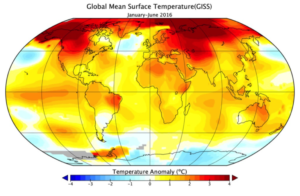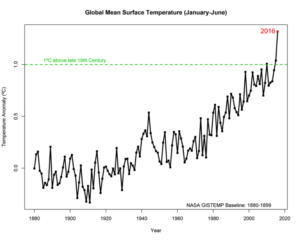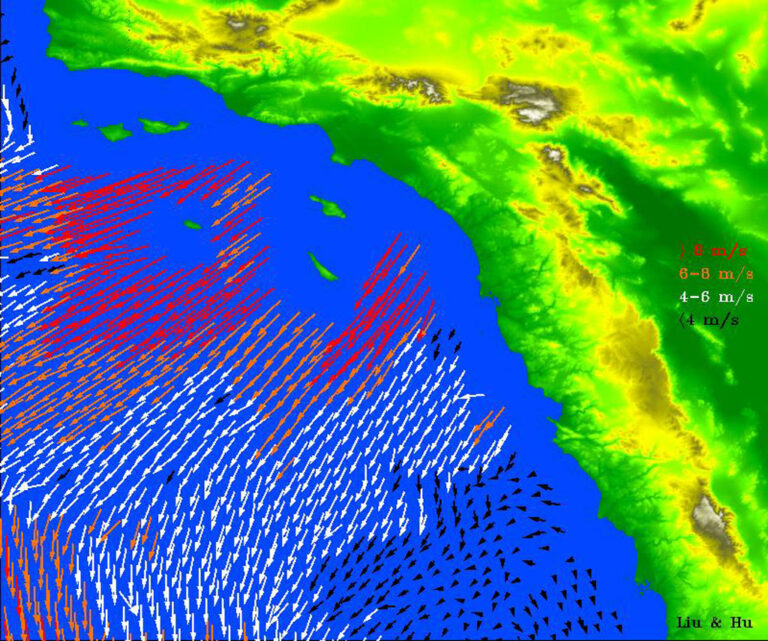The Long, Hot Summer
 It has been a long, hot summer. In July, the National Aeronautics and Space Administration (NASA) released its analysis of global temperatures for the first six months of 2016. Each of these months has set a record for global temperatures. Taken together, this marks the warmest six-month period since the record began in 1880. The temperatures for the first half of 2016 were about 1.3o C warmer than the late 19th century average. This is not a trivial amount. Two weeks ago, the National Oceanic and Atmospheric Administration (NOAA) released its analysis of August 2016 temperatures and found that it marks the 16th straight month of record-breaking temperatures for the globe. California, where I am writing this, is really feeling the heat. High evapotranspiration rates have locked the state in a condition of severe to exceptional drought according to the U.S. Drought Monitor.
It has been a long, hot summer. In July, the National Aeronautics and Space Administration (NASA) released its analysis of global temperatures for the first six months of 2016. Each of these months has set a record for global temperatures. Taken together, this marks the warmest six-month period since the record began in 1880. The temperatures for the first half of 2016 were about 1.3o C warmer than the late 19th century average. This is not a trivial amount. Two weeks ago, the National Oceanic and Atmospheric Administration (NOAA) released its analysis of August 2016 temperatures and found that it marks the 16th straight month of record-breaking temperatures for the globe. California, where I am writing this, is really feeling the heat. High evapotranspiration rates have locked the state in a condition of severe to exceptional drought according to the U.S. Drought Monitor.

My own research focuses upon long-term climatic change. For me, anomalously warm years are to be expected as a consequence of natural variability. In the case of 2016, a strong El Niño was certainly a contributing factor to the global warmth. However, the record-breaking start of 2016 comes on the heels of a similarly record-breaking 2015 and a 21st century which has experienced 14 of the 15 warmest January-June periods on record. Looking at annual temperatures, we find that nine of the 10 warmest years on record occurred in the 21st century. What is going on? Data from Scripps – UC San Diego shows that concentrations of atmospheric CO2 at Mauna Loa, Hawaii, reached 402.24 ppm this August. This beats the August 2015 record of 399.0. This equals an additional 6.9 Gt of carbon in the atmosphere compared to last year. Values have remained above 400 ppm throughout 2016. The August 2016 concentrations continue the long-term and seeming inexorable upward trend in greenhouse gases. Politicians may debate the degree of threat posed by climate change, but it is impossible to dismiss the accumulated observations that are evidence of the large amounts of greenhouse gases we are adding to the atmosphere and the record-breaking warming we are currently experiencing. It is, in my opinion, irresponsible to ignore numerous climate-modeling experiments that indicate that a significant portion of the warming is due to anthropogenic increases in greenhouse gases and that given current emissions trends, greater warming and associated climatic changes will occur over this century. Based upon a recently published study in Environmental Research Letters of a number of surveys and literature meta-analyses, it seems that well over 90 percent of climate scientists agree with this position. There remain uncertainties in model projections of future climate, but it is notable that even well-known ‘skeptic’ Patrick Michaels wrote in a Cato Institute Working Paper in December of last year “future global warming will occur,” although he argues for a rate of warming within the lower end of projections by groups such as the Intergovernmental Panel and Climate Change.

Geography and geographers have played and will continue to play a large role in tackling the scientific, environmental and societal challenges posed by global climate change. Although often portrayed as aspatial trend-lines on graphs, the climatic changes being experienced today and anticipated in the future have complex and important geographies. For example, a NASA map of 2016 temperature anomalies shows greatly enhanced warming across the higher latitudes of the Northern Hemisphere. The enhanced warming of the higher latitudes of the Northern Hemisphere is consistent with climate model projections of greenhouse gas effects. Some of the more local features are not as predictable and the response of the ice sheets and ice shelves of Antarctica remains particularly problematic. At more regional scales we see features such as cooling over much of the Antarctic, but pronounced warming over the Antarctic Peninsula and Larsen Ice Shelf. A 2013 study entitled “Ice-sheet mass balance and climate change” and published in Nature by University of Sheffield geographer Edward Hanna illustrates the uncertainties in measuring, much less anticipating, the reaction of Antarctic ice to climate change. When we look at global temperature or CO2 concentrations as lines on a graph, we miss the critical geographies of climate change.
I have worked in the Arctic for many years and offer it as an example. The NASA report cited above also provides a satellite image showing one of the most prominent vegetation changes related to increasing temperatures and CO2 — the increased greening of the North American Arctic. This increase in Arctic vegetation growth has taken place as temperatures and CO2 have risen from the late 1980s through the present century. In addition, NASA reported that five of the first six months of 2016 set records for low sea-ice cover in the Arctic. Summer sea ice has now declined to the point that this August the cruise ship, Crystal Serenity, embarked on the first excursion through Canada’s Northwest Passage by a large liner. The icy waters and barren islands that claimed Sir John Franklin and all hands on the HMS Erebus and HMS Terror in the cold years of 1845-1850 have become a destination for ships holding hundreds of tourists in the hot 21st century.

At the same time, fauna such as polar bears and the culture of the indigenous Inuit people face uncertain futures in the newly warmer Arctic. As pointed out in 2006 by geographer Claire Parkinson, a scientist with NASA Goddard Space Flight Center and sea-ice remote sensing expert, in a co-authored study in the journal Arctic, polar bear responses to climate change will potentially lead to changing bear-human interactions. My colleague at UCLA Larry Smith’s recent book “2050” examines the potential climate change impacts on both environment and society in the North, including the implications of increasing ease of marine transport. These are sweeping. Paradoxically, the Arctic is one of the lowest contributors of anthropogenic greenhouse gases on earth. Increasing atmospheric CO2 concentrations is a global phenomenon, but the production of greenhouse gases is a local to regional phenomenon tied to human population, socioeconomic, industrial and technological conditions. The impacts of climate change are similarly regional and local in nature. Regions of greatest emissions are often not the regions most vulnerable to the impacts of climate change. Geography is critical to understanding both.
I would suggest three important themes that our Association and its members might consider in research and education efforts as we confront climate change in the 21st century. The first is the need for continued efforts to understand the climatic effects and other environmental impacts of increasing greenhouse gases. There is much work that remains to be done in decreasing the uncertainties that exist, particularly at finer spatial and temporal scales. At a more general level, how precipitation regimes and ocean circulation will respond to increasing greenhouse gases remains particularly problematic. The questions that arise from how plant and animal species and communities will respond are incredibly complex and in many cases understanding remains superficial. There is plenty of work for physical geographers and biogeographers. This is work that engages large numbers of us now and will continue to motivate future generations of researchers and educators.
Second, the impacts of climate change will play out in a multitude of ways on human populations and both the social sciences and humanities traditions in geography must be engaged. Mitigation of greenhouse gas emissions and socioeconomic adaptation to the impacts of climate change are complex problems. How do we maintain economic vigor, while shifting to a less carbon intense economy? How do we do so without exacerbating geographic patterns of income inequality? How can we determine the likely local to regional effects of climate change on human health, resources, economic capacity…? How can we lessen those impacts on vulnerable populations – many of which are marginal contributors to the greenhouse gas problem in the first place? In 2010, geographer Robin Mearns of the World Bank co-edited an important compendium, “Social Dimensions of Climate Change: Equity and Vulnerability in a Warming World,” that illustrates the importance and complexity of these issues.
In addition to the points raised above, there are deeper concerns at play here. How do you preserve the cultures of people, like the Inuit, which were formed in environments which are now changing dramatically? How do we preserve cultures and identities of peoples whom live on islands which may be completely lost? Tuvalu in the Pacific being one example. Even if we find answers, mitigation and adaptation require will and in many cases some sacrifice. What then drives cultures to value the environment or to feel responsible enough for other cultures and peoples to undertake altruistic actions? The humanities tradition within geography has a central part to play in tackling climate change mitigation and adaptation. In doing so the humanities can also open doors to deeper understanding of ourselves. Mike Hulme, currently professor of climate and culture in the department of geography at King’s College, has long argued for the critical role of social studies and humanities in climate change work. In 2011, Hulme wrote persuasively on this topic in the scientific journal Nature Climate Change. The article had a simple and effective title “Meet the humanities.” Indeed.
Third, we must remain cognizant that climate change, although of immense importance, is not the only challenging issue facing the environment and society in the 21st century. From land-use intensification and modification of the earth’s surface, to resource extraction, to pollution, to food security, to economic inequality, to health, to conflict, etc., there are a plethora of issues that confront us in the 21st century. Although, the impacts of any of these may be most readily manifested locally and regionally, the forces of globalization overlay all of this. In terms of these challenges and their solutions, what is local is global in many instances. Moving forward, the optimal solutions for climate change mitigation and adaptation will be those that also aid in responding to these other challenges. At the very least, our climate change strategies should not exacerbate things like economic inequality.
Meaningfully addressing the issues of climate change is not going to be easy – the winds of change we face will blow strongly and at times unpredictably. On the other hand, nowhere is the opportunity for the broad span of our discipline to work together clearer or more pressing. Climate change is one of the central challenges we face in the 21st century. Geographers have contributed much already and it is our continued responsibility to rise to this challenge. In doing so, however, we will also be rewarded with an endeavor which can serve as a powerful glue to meld the varied elements of our discipline together into a common and crucial purpose.
Join the conversation and share your thoughts on Twitter #PresidentAAG.
— Glen M. MacDonald

